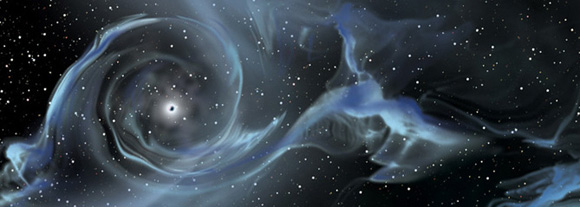Primordial black holes remain an intriguing option to potentially explain dark matter. A new study has found a plausible scenario for creating them in the early universe.
Astronomers do not understand roughly 80% of the mass of every galaxy. The unknown portion is known as dark matter, and astronomers typically assume that it’s a form of matter that does not interact with light. One option for the dark matter is for it to be made of black holes, which as their name suggests do not emit radiation. However, these black holes cannot be made through the deaths of stars. First, there haven’t been enough generations of stars in the age of the universe to produce enough black holes. And second, even if the universe was older, there simply isn’t enough raw material to make enough stars in the first place. So this kind of black hole formation can’t explain all of the dark matter.
Instead if we want to make the dark matter be made out of black holes, those black holes have to be primordial. That means they are not made from the deaths of massive stars, but instead through some exotic process in the early universe.
However, an abundance of cosmological observations have ruled out most ranges of masses for these primordial black holes, leaving behind only a relatively narrow window. So the challenge for theorists is to find a plausible mechanism for generating primordial black holes in sufficient numbers with the masses that fit observations.
In the Standard Model of particle physics there is no mechanism to create black holes in the early universe. But we know that the Standard Model is incomplete, and that new physics is right around the corner. A new study has examined extensions to the Standard Model and found a new way to create black holes .
Most scenarios for creating primordial black holes rely on what’s called a first-order phase transition. In this case, in the incredibly early universe the fundamental nature of the quantum fields that soak all of space-time change their character in a violent, rapid way. This transition started with many nucleation points that expanded into bubbles.
It’s easy to form primordial black holes in that scenario because it’s so chaotic and violent. But the new study has found even smooth transitions can still lead to the formation of black holes. The key is that some of the quantum fields remain strongly coupled together. As they slowly transition their interactions can spike, leading to pockets of extremely high energy density. These collapse into black holes which then flood the universe.
While intriguing, there is still a lot of work to do. Physicists will have to flesh out the details of this theory to see if it is physically plausible. And astronomers will have to find ways to directly observe these populations of primordial black holes. Until then the dark matter mystery is still open.

